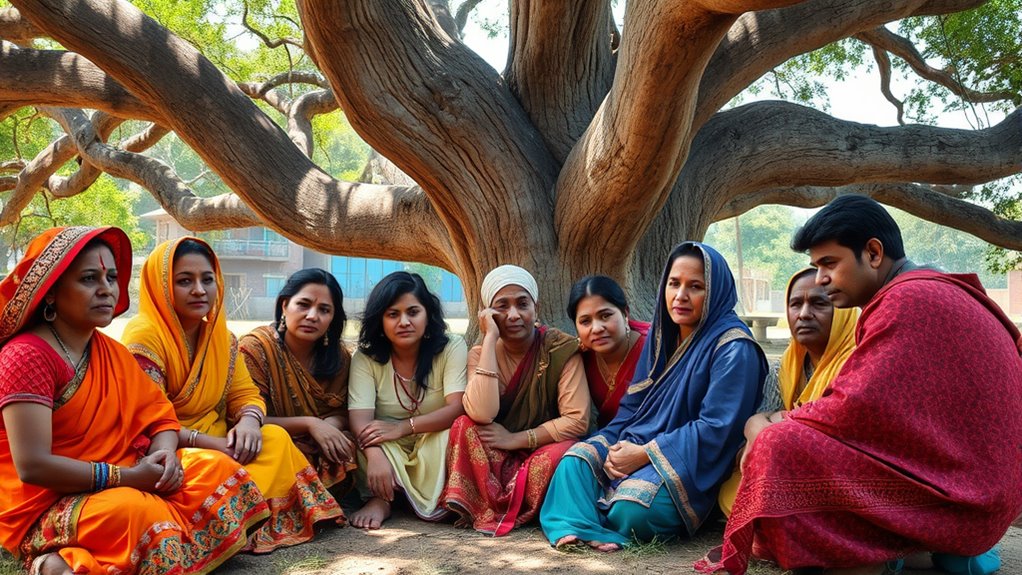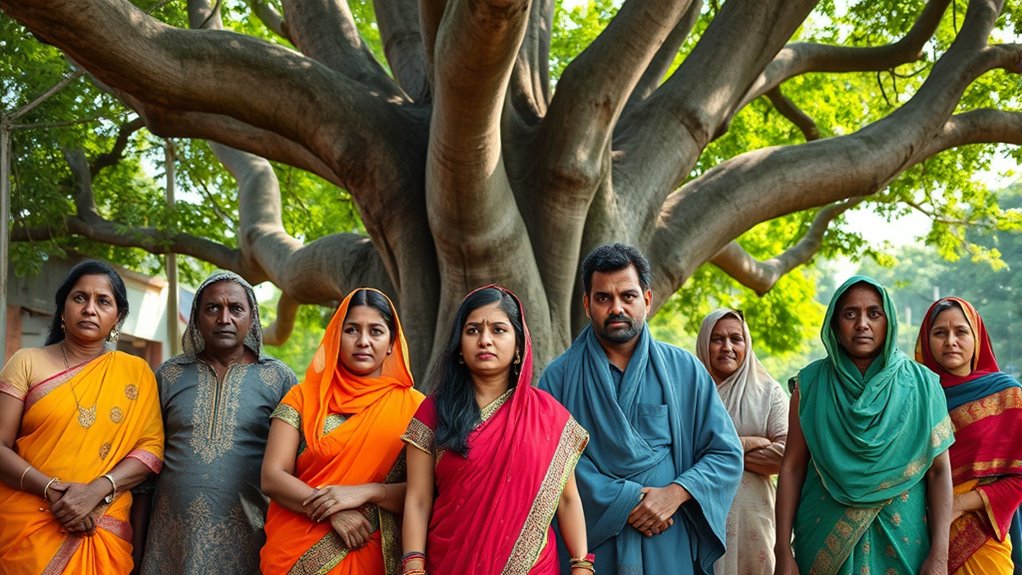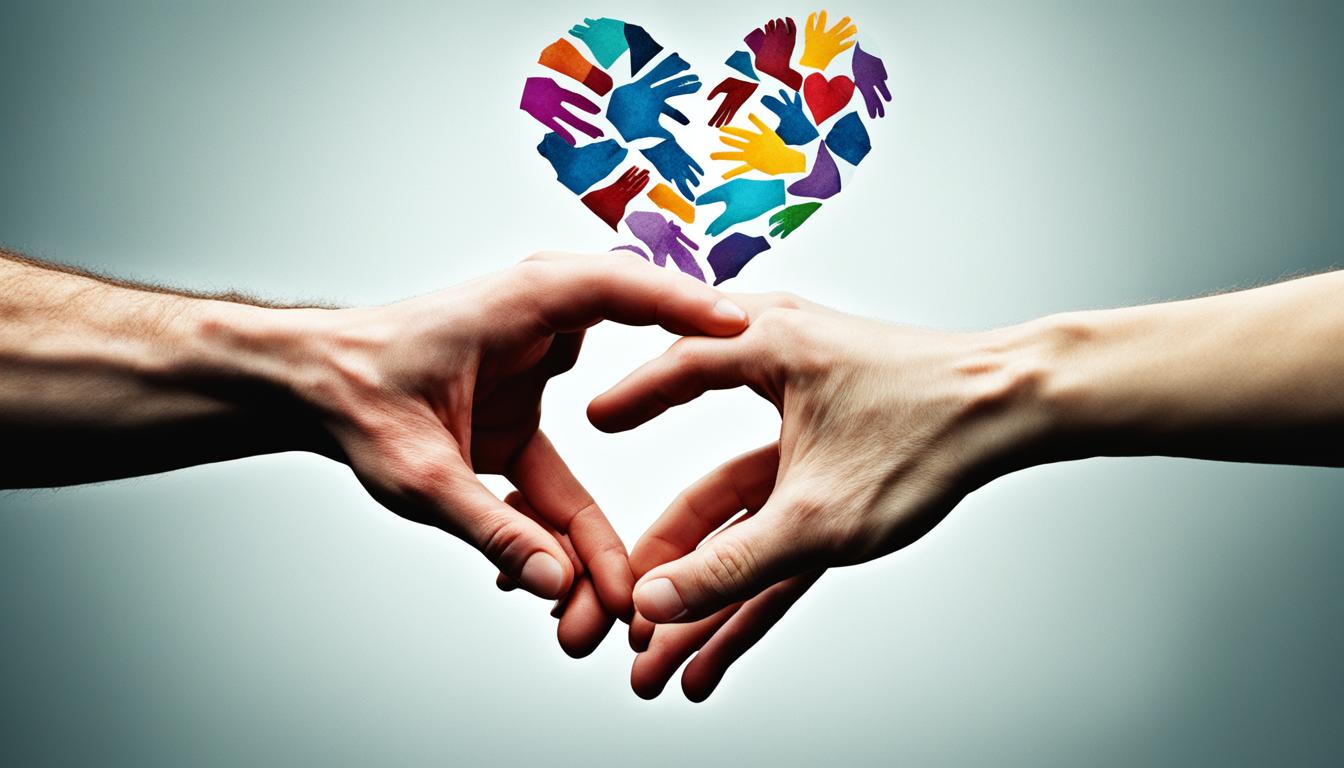Borderline Personality Disorder shows different signs across cultures, shaped by social norms, values, and self-identity. In Western societies, symptoms often include impulsivity and self-harm, while in collectivist cultures, issues relate more to relational disturbances and internalized distress. Cultural norms also influence emotional expression, shame, and relationship styles, making diagnosis complex. Recognizing these differences, along with culturally respectful treatments, helps improve understanding and care—if you continue exploring, you’ll discover more about these nuanced variations.
Key Takeaways
- Cultural norms influence how BPD symptoms like emotional instability and relationship issues are expressed across societies.
- Collectivist cultures may manifest BPD traits as relational disturbances rather than individual impulsivity.
- Cultural syndromes such as Ataque de Nervios and Koro overlap with BPD features, reflecting specific cultural influences.
- Language barriers and assessment biases can hinder accurate diagnosis of BPD in diverse cultural contexts.
- Culturally sensitive approaches improve diagnosis, treatment engagement, and outcomes for individuals with BPD worldwide.
Variations in Symptom Expression Across Cultural Contexts

Cultural norms shape how BPD symptoms appear, affecting emotional expression and behavioral patterns. These differences lead to distinct symptom variation across cultures. In Western societies, impulsivity and self-harm are common signs, reflecting open emotional expression and individualism. Conversely, in non-Western cultures, symptoms often manifest as relational disturbances or internalized distress, influenced by collectivist values that emphasize family cohesion. Cross-cultural differences also influence how fear of abandonment and relationship instability are expressed, with some cultures viewing these feelings through a lens of social harmony. Additionally, culturally bound syndromes like Ataque de Nervios demonstrate how specific cultural contexts shape symptom presentation. These differences contribute to mental health disparities, affecting diagnosis and treatment approaches worldwide and are often linked to cultural expression of emotional struggles. Recognizing these cultural variations is essential for developing culturally sensitive mental health interventions and improving patient outcomes globally. Understanding the cultural context is also crucial for clinicians to accurately assess and address the unique ways symptoms manifest across diverse populations. Furthermore, awareness of cultural influences on emotional regulation can enhance therapeutic approaches and foster more effective patient-clinician communication.
Cultural Norms and Their Impact on Emotional Regulation

Your cultural norms shape how you express and regulate emotions, with some societies favoring suppression to preserve harmony. In certain cultures, hiding feelings is seen as a mark of strength, influencing how emotional dysregulation shows up. These cultural expectations around shame and guilt also affect how emotions are experienced and expressed. Understanding emotional regulation strategies can help explain these differences across cultures. Additionally, the use of protective styling techniques, like crochet styles for locs, reflects cultural values related to self-expression and identity. Recognizing how cultural emotional norms influence individual behavior can lead to more effective cross-cultural communication and mental health support. Furthermore, awareness of these norms is crucial when considering cultural differences in emotional expression, as it can impact diagnosis and treatment in multicultural settings. For example, some cultures might emphasize emotional suppression more heavily, which can be misinterpreted in clinical assessments.
Emotional Suppression Norms
In many collectivist societies, social harmony and reputation often take precedence over individual emotional expression, leading you to suppress your feelings to avoid shame or conflict. This cultural norm shapes emotional regulation, encouraging emotional restraint to meet social expectations. You might notice that expressing intense emotions publicly is discouraged, especially in countries like Japan and Korea. These cultural influences promote emotional suppression, which can impact mental health over time. Moreover, the social norms often dictate acceptable emotional behaviors, reinforcing restraint across different contexts. For example, studies show that cultural expectations significantly influence emotional regulation strategies. Emotions are often labeled with specific words for shame or guilt, reinforcing restraint. Physical symptoms, like somatic complaints, are used to express emotional distress. Suppressing feelings can increase internalized stress and vulnerability. Additionally, psychological effects of emotional suppression may include increased anxiety and depression, highlighting the importance of understanding these norms. Cultural norms shape how emotional regulation aligns with social harmony and personal well-being. Understanding emotional regulation strategies is crucial for addressing the psychological effects of these cultural norms. For example, some societies develop cultural coping mechanisms to manage emotional suppression in healthy ways.
Expression of Feelings
The way people express their feelings is deeply shaped by cultural norms, with some societies encouraging openness while others promote restraint. These cultural differences influence emotional expression and how emotional dysregulation manifests. Cultural norms also influence the development of emotional regulation strategies, shaping how individuals learn to manage their feelings from a young age. In cultures that discourage emotional disclosure, you might notice more internalized feelings and somatic complaints, as physical symptoms often serve as outlets for unspoken emotions. Conversely, expressive behaviors are more common in individualist societies that value open emotional sharing. Additionally, cultural variation impacts the perception and interpretation of emotional shifts, affecting both diagnosis and treatment approaches. Recognizing emotional expression differences across cultures can be essential for accurate diagnosis and effective treatment planning. Moreover, understanding emotion regulation strategies across different cultural contexts can improve therapeutic outcomes.
Cultural Shame Dynamics
Cultural norms shape how individuals experience and express shame, directly impacting emotional regulation strategies. In collectivist societies, social norms promote emotional suppression to preserve harmony, often leading to cultural shame that influences behavior. For example, in Japan and Indonesia, shame is openly experienced and expressed, affecting how people handle distress. Language differences can obscure emotional shifts, complicating recognition of affective changes. Shame internalization varies cross-culturally, with some societies emphasizing shame more than guilt, affecting emotional regulation. Physical symptoms like somatic complaints serve as culturally acceptable expressions of distress rather than direct emotional expression. Additionally, cultural expression of shame can differ significantly depending on societal values and communication styles. – Cultural shame influences emotional regulation through social norms. – Emotional suppression is common in collectivist cultures. – Cultural expression of shame varies across societies. – Language and cultural standards shape shame internalization. Furthermore, cultural norms also dictate which emotional responses are deemed appropriate, thereby shaping individual coping mechanisms.
Differences in Self-Identity and Relationship Dynamics

Differences in self-identity and relationship dynamics shape how individuals with BPD experience and express their symptoms across cultures. Cultural context influences whether self-identity is rooted in personal autonomy or family roles, affecting emotional dysregulation and self-perception.
In Western societies, a fragmented or unstable self-image is common, whereas collectivist cultures emphasize relational identity and social harmony, shaping how fears of abandonment manifest.
Relationship dynamics also vary; cultures valuing independence may see more overt instability, while those emphasizing interdependence interpret relationship challenges through familial duty and social cohesion.
These cross-cultural differences influence how interpersonal relationships are navigated and understood, demonstrating that cultural norms deeply shape BPD’s presentation, especially in how individuals perceive themselves and manage emotional dysregulation within their social environment.
Culture-Bound Syndromes Related to BPD Manifestations

Variations in how different cultures interpret and express mental health symptoms can lead to unique, culturally specific syndromes that overlap with BPD features. These culture-bound syndromes illustrate cross-cultural differences in how emotional dysregulation and impulsivity manifest.
For example:
- Ataque de Nervios involves somatic symptoms like trembling and fainting, common in Puerto Rican and Caribbean populations.
- Koro features a culturally specific fear of genital retraction, seen mainly in Asia, Africa, and Europe.
- HwaByung reflects suppressed anger, with transient emotional dysregulation often linked to Korean cultural influences.
- Dhat syndrome involves anxiety over semen loss, highlighting emotional distress in Indian and Southeast Asian contexts.
These syndromes demonstrate how culturally specific symptoms shape mental health presentations and contribute to diagnostic variability across cultures.
Challenges in Cross-Cultural Diagnosis and Assessment

When diagnosing BPD across cultures, you need to recognize that symptoms may look different depending on cultural norms and values.
Language barriers and variations in emotional expression can obscure understanding, making assessments less reliable.
Additionally, cultural biases in diagnostic tools can lead to misinterpretation, so you must consider context and worldview for accurate evaluation.
Cultural Symptom Variability
Cultural norms shape how BPD symptoms like emotional dysregulation and interpersonal instability are expressed and understood, making diagnosis more complex across different societies.
Variations in symptom expression, such as risk-taking or somatic complaints, result from cultural influences, complicating cross-cultural diagnosis.
Behaviors like arguing or self-harm may be culturally acceptable forms of distress, differing from Western views.
Language differences and idioms of distress can obscure symptom recognition, leading to misdiagnosis.
To address diagnostic challenges, clinicians must consider cultural symptom variability and adapt assessment tools accordingly.
Understanding these cultural influences helps ensure accurate diagnosis and treatment.
- Recognizing culturally specific symptom expression
- Adjusting assessment tools for cultural relevance
- Interpreting idioms of distress accurately
- Overcoming diagnostic challenges in diverse populations
Language and Expression Barriers
Language and expression barriers pose significant challenges in diagnosing BPD across different cultures. Variations in language can lead to misinterpreting emotional states, as some cultures use words that express multiple emotions or lack direct equivalents for clinical terms.
Cultural norms influence how people express mood and distress, with some societies suppressing emotions, making symptoms like impulsivity harder to detect. Nonverbal communication, including gestures and facial cues, also varies, affecting your ability to accurately interpret symptoms.
Translation issues and the absence of culturally adapted diagnostic tools may cause underdiagnosis or overdiagnosis in non-Western populations. Additionally, cultural norms around mental health disclosure influence patients’ willingness to report symptoms, creating assessment barriers that hinder accurate diagnosis and understanding of BPD across diverse cultural contexts.
Cultural Biases in Diagnosis
Diagnosing BPD across different cultures often reflects the biases and assumptions of clinicians trained primarily in Western contexts. Cultural biases can distort clinical judgment, leading to misdiagnosis or underdiagnosis.
Diagnostic challenges stem from differences in cultural norms, which influence the expression of symptoms like impulsivity or self-harm. Standard assessment tools may not account for culturally specific behaviors, such as somatic complaints or culturally sanctioned actions.
Language barriers, stigma, and idioms of distress further complicate cross-cultural diagnosis, risking inaccurate evaluations. Without culturally adapted tools and training, clinicians may overlook or misinterpret symptoms, reinforcing biases.
- Cultural biases shape how symptoms are perceived and diagnosed
- Cultural norms determine whether behaviors are seen as pathological
- Assessment tools often lack cultural sensitivity
- Language and stigma impact symptom reporting
Influence of Cultural Values on Interpersonal Conflict and Stability

Your cultural background profoundly influences how you perceive and handle interpersonal conflict, shaping expectations around communication and resolution. In collectivist cultures, harmony and face-saving lead to indirect communication, reducing overt conflict but fostering subtle tensions. Conversely, individualist societies promote open emotional expression and direct conflict resolution, emphasizing personal autonomy. These cultural influences impact perceptions of relationship stability; collectivist cultures prioritize family and community, while individualist societies value independence. Differences in emotional expression and conflict management affect relationship outcomes, with some cultures viewing conflict as disruptive and others as natural. Understanding these cultural influences helps you navigate interpersonal conflicts more effectively and recognize how cultural values shape emotional responses and relationship stability across diverse societies.
| Cultural Values | Conflict Resolution Style |
|---|---|
| Collectivist | Indirect, harmony-focused |
| Individualist | Direct, confrontation-prone |
Cultural Perspectives on Self-Harm and Suicidality

Have you ever wondered how cultural backgrounds shape the way self-harm and suicidality are understood and expressed? Cultural influences deeply affect emotional expression and the way individuals with BPD communicate distress.
Cultural backgrounds shape how self-harm and suicidality are understood and expressed across societies.
In Western societies, self-harm and suicidality are often seen as signs of emotional dysregulation and interpersonal issues.
Conversely, in some Asian cultures like Japan and Korea, acts of self-harm may be linked to shame and social conformity, serving as private communication of distress.
In Middle Eastern or Mediterranean regions, suicidality might be culturally accepted or seen as an inevitable response to shame.
These cross-cultural differences impact diagnosis and treatment, as stigma and norms influence how behaviors are reported and interpreted.
Recognizing these variations is essential for culturally sensitive understanding and care.
Implications for Culturally Sensitive Treatment Approaches

Understanding how cultural backgrounds influence the way self-harm and suicidality are expressed highlights the importance of tailoring treatment approaches for individuals with BPD.
Cultural sensitivity in treatment approaches involves recognizing cross-cultural differences in emotional expression and interpersonal behaviors shaped by cultural norms. Adapting diagnostic tools and therapeutic interventions ensures accurate assessment and culturally appropriate care, reducing mental health disparities.
When developing treatment plans, consider factors like family dynamics, religious beliefs, and social expectations to improve engagement and adherence.
Cross-cultural competence and cultural humility in clinicians help deliver respectful and effective interventions for diverse populations.
Ultimately, culturally sensitive strategies foster trust, enhance outcomes, and support individuals with BPD in orienting themselves within their unique cultural contexts.
Resources and Strategies for Culturally Competent Practice

To provide effective care for individuals with BPD across diverse cultural backgrounds, clinicians should utilize specialized training modules on cultural competence. These resources enhance your ability to develop assessment strategies that consider cultural influences on symptom presentation and coping mechanisms.
Engaging in clinical training through professional organizations or online platforms helps deepen cross-cultural understanding and reduces mental health disparities.
Incorporating culturally sensitive treatment approaches involves diagnostic adaptation, ensuring behaviors are interpreted within the patient’s cultural context.
Staying current with resources like research articles, workshops, and podcasts supports ongoing professional development. This continuous learning fosters cultural humility and improves your capacity to deliver tailored, effective interventions for diverse populations.
- Cultural competence training modules
- Assessment strategies for diverse populations
- Culturally sensitive diagnostic practices
- Resources for ongoing professional development
Frequently Asked Questions
What Ethnicity Is Most Affected by BPD?
You might wonder which ethnicity is most affected by BPD. While globally, prevalence is around 1-2%, studies show higher diagnosis rates among White populations, especially in Western countries. However, this could be influenced by cultural awareness and diagnostic biases.
Minority groups, like African Americans and Latin Americans, may experience underdiagnosis. Cultural differences shape how symptoms manifest and are recognized, making it hard to identify a specific ethnicity most impacted.
Where in the World Is BPD Most Common?
You might wonder where BPD is most common worldwide. While Western countries like the US and UK report about 1% prevalence, data from other regions are limited and less reliable.
Cultural differences can affect how symptoms are expressed and diagnosed, making it hard to pinpoint exact rates globally. Factors like social support and stigma also influence recognition, so true prevalence likely varies and is underestimated outside Western contexts.
How Does Culture Influence BPD?
You might think culture doesn’t affect mental health, but it truly shapes how BPD shows up. In collectivist societies, you could see more loyalty and enmeshment rather than overt instability.
Emotional suppression might hide impulsivity or risky behaviors. Cultural beliefs also influence how symptoms like self-harm or suicidality are understood and diagnosed.
Recognizing these cultural differences helps you better interpret and treat BPD across diverse populations.
What Is the Life Expectancy of Someone With BPD?
Your question about life expectancy highlights that individuals with BPD typically face a shorter lifespan, about 10-15 years less than the general population. This increased risk mainly comes from suicide, which makes up around 70% of deaths.
However, with effective treatment, early intervention, and continuous support, you can improve health outcomes and potentially extend your lifespan.
This emphasizes the importance of managing symptoms and seeking help.
Conclusion
Understanding BPD across cultures is like tending a delicate garden—each setting brings unique blooms and weeds. By recognizing these differences, you can nurture more compassionate, culturally attuned care. Remember, empathy is the compass guiding your journey through diverse emotional landscapes. When you honor cultural roots, you help patients find stability amid the swirling winds of their identities. Together, you can cultivate healing that blossoms across every cultural horizon.









